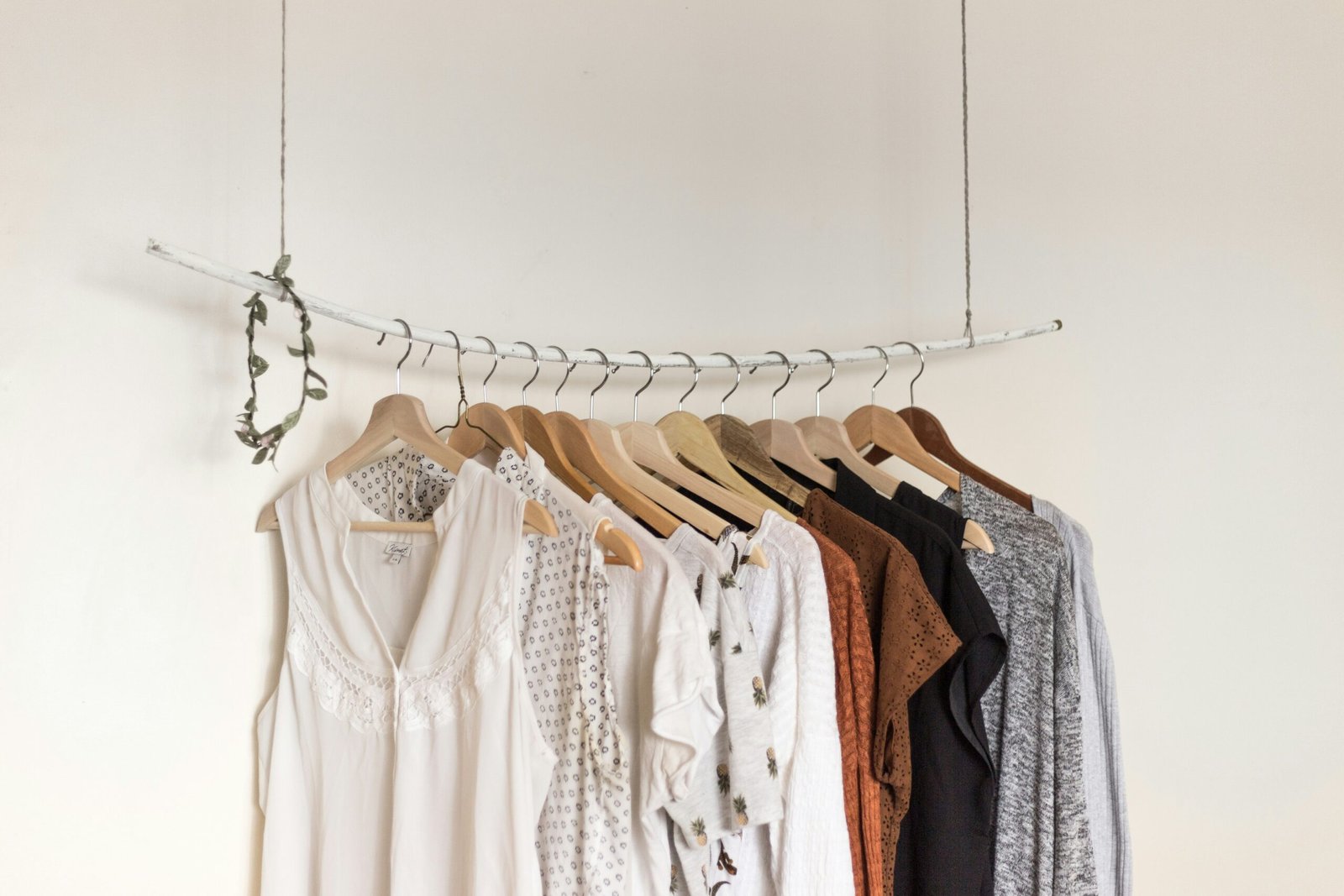Introduction to Sustainable Fashion
Sustainable fashion is an evolving concept that addresses the profound implications of the global clothing industry on both the environment and society. It emphasizes a more responsible approach to producing and consuming garments, engendering a shift away from the traditional fast fashion model characterized by rapid production cycles and disposable clothing. With increasing awareness of the detrimental effects of the fast fashion industry—such as excessive waste, pollution, and exploitation of labor—there is a growing necessity for conscientious fashion choices.
The production processes associated with fast fashion are notoriously resource-intensive, consuming vast amounts of water, energy, and raw materials while generating considerable pollution. In addition, the social impact cannot be overlooked; often, laborers work in unsafe conditions with minimal pay, perpetuating cycles of poverty. Therefore, understanding sustainable fashion is about recognizing these challenges and advocating for ethical production and responsible consumption.
Embracing sustainable fashion involves appreciating the benefits of a mindful wardrobe, which prioritizes quality over quantity. This shift entails making informed decisions about clothing purchases, considering factors such as material sourcing, manufacturing practices, and overall lifecycle impact. Sustainable wardrobes are not only beneficial for the environment but also foster a deeper connection to individual style and personal values.
As we delve deeper into the principles and practices of building a sustainable wardrobe, it is essential to recognize that every small decision counts. By gradually implementing more sustainable choices into our lives, we contribute to a collective movement towards a more ethical and eco-friendly fashion industry. The following sections will provide practical tips and tricks to help individuals navigate this transition and foster a sustainable wardrobe that resonates with their ideals.
Assessing Your Current Wardrobe
The first step in building a sustainable wardrobe is to comprehensively assess your current clothing collection. This evaluation process will help you identify sustainable items that align with your values and pinpoint those that may no longer serve you. Begin by removing all clothing from your wardrobe, laying them out to gain a clear perspective on what you own. Take time to examine each piece critically.
As you review your clothing items, consider their material composition and origin. Sustainable fashion often includes garments made from organic, recycled, or ethically sourced materials. Look for labels indicating eco-friendly certifications or transparent manufacturing processes. While evaluating your belongings, categorize them into three groups: keep, donate, and recycle. This approach will facilitate responsible decluttering.
When deciding on what to keep, reflect on your lifestyle and personal style preferences. Determine which pieces are versatile, timeless, and align with your aesthetics. It is important to retain items that you truly love and wear regularly, as these contribute to a functional, sustainable wardrobe. On the other hand, items that no longer fit, are damaged beyond repair, or have seen little wear should be considered for donation or recycling.
Donating garments in good condition to local charities or thrift stores ensures they are given a second life, while recycling options can be explored for items that cannot be salvaged. Many brands now offer textile recycling programs, addressing fashion waste. Understanding your personal style will not only streamline your wardrobe but also inform your future purchases, allowing you to make intentional, mindful choices that contribute to a more sustainable fashion ethos.
Choosing Quality Over Quantity
In today’s fast-fashion landscape, the temptation to buy clothing in bulk can be overwhelming. However, prioritizing quality over quantity is essential for building a sustainable wardrobe. Investing in high-quality garments not only reduces waste but also ensures that each piece remains timeless and functional for years to come. When selecting clothing, it is crucial to identify durable fabrics; natural materials such as cotton, linen, wool, and silk tend to have superior longevity compared to synthetic counterparts. Look for garments that are made from heavy-weight fabrics or blended materials, as these often withstand wear better.
Well-made clothing offers several benefits that extend beyond mere aesthetics. Garments constructed with care typically feature reinforced seams, quality stitching, and attention to detail, all of which add to their durability. Moreover, these pieces often fit better and provide greater comfort, enhancing the overall wearing experience. Investing in key items, such as a tailored jacket, classic trousers, or quality shoes, can significantly elevate one’s wardrobe while minimizing the need for frequent replacements.
From a financial perspective, embracing a philosophy of purchasing fewer but better-quality items can be more cost-effective in the long run. Although the initial investment may be higher, well-made clothing often lasts longer, saving consumers money on replacements. Additionally, focusing on quality allows for a more versatile and cohesive wardrobe, making it easier to mix and match outfits without excessive buying.
To ensure that your high-quality pieces stand the test of time, proper care is paramount. Follow washing instructions diligently, consider air-drying over machine-drying, and store garments thoughtfully. Regularly rotating your wardrobe also prevents excessive wear on any single item. By adopting these practices, individuals can cultivate a sustainable wardrobe rooted in quality and longevity.
Understanding Sustainable Materials
In today’s fashion industry, the movement towards sustainability has become more prominent than ever, prompting consumers to seek out clothing made from sustainable materials. One of the most widely recognized options is organic cotton. Unlike conventional cotton, which is often grown using harmful pesticides and synthetic fertilizers, organic cotton is cultivated without these chemicals, reducing its environmental impact. This environmentally friendly alternative not only conserves water but also promotes soil health and supports biodiversity.
Another notable sustainable material is Tencel, a fiber derived from sustainably sourced wood pulp, primarily from eucalyptus trees. Tencel production utilizes a closed-loop process, meaning that the solvents used are recycled and reused, resulting in minimal waste and lower emissions. Furthermore, Tencel is biodegradable and has a soft, luxurious feel, making it an appealing choice for consumers seeking both sustainability and comfort.
Recycled materials also play a crucial role in sustainable fashion. By repurposing discarded textiles or plastic bottles, brands can significantly reduce waste and the demand for new, virgin materials. Recycled polyester, for example, offers similar qualities to traditional polyester while minimizing the environmental costs associated with petroleum extraction and processing. This innovative approach aids in diverting waste from landfills and lowers the carbon footprint of garment production.
To make informed choices, consumers must develop an understanding of how to read clothing labels effectively. Terms like “organic,” “recycled,” and “eco-friendly” can signal a brand’s commitment to sustainability. Additionally, certifications from reputable organizations can provide further assurance that a product meets established environmental standards. By recognizing brands that prioritize sustainable materials, individuals can contribute to a more eco-conscious fashion industry and make a positive impact on the planet.
Thrifting and Second-Hand Shopping
Thrifting and second-hand shopping have gained tremendous popularity as effective means of building a sustainable wardrobe. By opting for pre-owned garments, individuals can discover unique pieces that reflect personal style while also minimizing environmental impact. One of the key benefits of shopping second-hand is the reduction of waste. Each item you purchase gives it a second life, contributing to a more sustainable fashion industry.
When searching for quality second-hand clothing, it is essential to explore a variety of sources. Local thrift stores and consignment shops frequently offer a rotating selection of items at affordable prices. Additionally, community events such as clothing swaps can be fantastic opportunities to refresh your wardrobe without spending money. Online platforms have also emerged as valuable resources for second-hand shopping. Websites and apps dedicated to pre-owned fashion, such as Poshmark, Depop, and ThredUp, provide a convenient way to find high-quality clothing from the comfort of your home.
The joy of treasure hunting in thrift stores cannot be understated. Each visit holds the promise of discovering distinctive clothing that may not be available in mainstream retail shops. Finding a vintage jacket or a pair of unique shoes fosters a sense of victory and satisfaction. This experience not only adds a personal touch to one’s wardrobe but also cultivates an appreciation for fashion history and craftsmanship.
Engaging in thrifting or purchasing second-hand clothing is an impactful choice that contributes positively to the environment. By choosing to prioritize sustainable fashion practices, individuals help reduce the demand for fast fashion, which is often characterized by poor labor practices and significant ecological footprints. Embracing the second-hand shopping culture not only enriches one’s wardrobe but also aligns with eco-friendly living principles, making it a rewarding pursuit in the journey toward a sustainable lifestyle.
Building a Capsule Wardrobe
A capsule wardrobe is a strategic approach to fashion that emphasizes quality over quantity, focusing on a small collection of versatile clothing items that can be mixed and matched. This concept not only simplifies the dressing process but aligns closely with sustainability principles by reducing consumption and waste. To begin creating a capsule wardrobe, it is important to evaluate your personal style and daily needs, which allows you to select key pieces that resonate with your lifestyle and preferences.
The philosophy behind minimalism in fashion encourages individuals to select versatile items that can serve multiple purposes. Start by identifying essential garments—items that can be worn for various occasions and paired with differing outfits. A typical capsule wardrobe might include a well-fitted pair of jeans, a classic white shirt, a versatile dress, and a tailored blazer. Each of these pieces can be dressed up or down depending on the context, ensuring that you always have appropriate attire without excess clothing cluttering your space.
When curating your wardrobe, consider factors such as fabric quality, color palette, and design timelessness. Opt for items that are durable, ethically produced, and ideally, made from sustainable materials. Not only does this support ethical fashion practices, it contributes to a reduced environmental impact by minimizing the frequency of replacements and potential landfill waste. A neutral color palette can further enhance versatility, making it easier to coordinate pieces and create a variety of outfits.
Ultimately, building a capsule wardrobe is a conscious effort to embrace sustainable fashion habits. By focusing on fewer, high-quality items, you will cultivate a personal style that is both sustainable and enriching, fostering a mindful relationship with your clothing. This approach not only elevates your wardrobe but also promotes a broader commitment to sustainable living.
Supporting Sustainable Brands
Building a sustainable wardrobe goes hand in hand with supporting brands that prioritize environmental and ethical practices. As consumers, our purchasing decisions wield significant power, ultimately influencing industry standards and promoting sustainability. To begin, it is crucial to research brands meticulously to understand their commitment to sustainable fashion.
Start by examining a brand’s transparency regarding their supply chain. Look for details about ethical sourcing, where the materials originate, and whether they are derived from renewable sources. Brands that are genuinely committed to sustainability will often provide information about their materials, highlighting organic cotton, Tencel, or recycled fabrics. Additionally, investigate whether they conduct fair labor practices by ensuring safe working conditions and fair wages for their employees. Certifications to look out for include Fair Trade, GOTS (Global Organic Textile Standard), and B Corp, which validate a brand’s commitment to social and environmental performance.
Another aspect to consider is the brand’s production methods. Sustainable brands frequently implement eco-friendly techniques such as using low-impact dyes, reducing water consumption, or minimizing waste through innovative designs. Further, some brands adopt circular fashion principles, encouraging customers to recycle or repurpose garments at the end of their life cycle. Brands like Patagonia, Everlane, and Reformation have made notable strides in these areas, setting examples for the broader fashion industry.
To stay updated, utilize online resources and platforms that specialize in ethical fashion. Websites such as Good On You and Fashion Revolution provide valuable insights and reviews on various brands, assisting consumers in making informed choices. By consciously supporting sustainable brands, individuals can contribute to a collective movement toward a more responsible and eco-conscious fashion landscape.
Caring for Your Clothes Sustainably
To build a sustainable wardrobe, it is essential to adopt practices that prolong the life of your clothing. Proper care involves several considerations, including washing, drying, and storage. Each step in the process significantly impacts the longevity of your garments. By incorporating sustainable strategies into these activities, you not only reduce wear and tear but also minimize the environmental footprint associated with clothing maintenance.
When it comes to washing, it is advisable to machine wash clothes only when necessary. This practice can significantly reduce the wear associated with frequent laundering. Opt for cold water settings, as heating water contributes to energy consumption. Additionally, utilizing a natural detergent can lessen the chemical impact on the environment while being gentler on your fabrics. Furthermore, consider filling the washing machine to capacity without overcrowding it to maximize resource efficiency.
Drying is another crucial phase where sustainable practices can be beneficial. Air drying your clothes instead of using a dryer reduces energy use and can also help maintain the fabric quality over time. If a dryer is necessary, using a lower heat setting can minimize damage. It is also worth mentioning that reading garment care labels before washing and drying can provide crucial guidance on maintaining specific items effectively.
Proper storage also plays a significant role in caring for clothes sustainably. Instead of cramming garments into cramped spaces, utilize breathable garment bags and hangers that support the shape of your clothing. This careful storage can help prevent wrinkles and fabric distortions. In addition, addressing minor damages through repairs instead of immediately discarding items is a sustainable practice that encourages a mindful approach to wardrobe management. Simple sewing skills can extend the life of a garment considerably, reducing waste and promoting a more sustainable clothing culture.
The Importance of Mindful Shopping
The concept of mindful shopping has gained traction in recent years, especially within the context of building a sustainable wardrobe. This approach emphasizes thoughtful decision-making and encourages consumers to focus their purchasing habits on long-term value rather than immediate gratification. By adopting mindfulness in shopping, individuals can significantly reduce waste and contribute positively to the environment.
To enhance your shopping experience, start with creating a shopping list. This list should be informed by your existing wardrobe and gaps within it. By identifying what you genuinely need, you can avoid unnecessary purchases that will ultimately clutter your life. Establishing a budget is equally important. It allows you to allocate funds for essential items, ensuring that you do not fall prey to impulse buys, which can derail your financial goals and lead to unplanned environmental impact.
Before making a purchase, it is vital to ask specific questions regarding a product’s sustainability. Consider the materials used in its production, the mindfulness of labor practices, and the brand’s commitment to environmental responsibility. Products that are sustainably sourced, ethically produced, and durable ultimately provide better long-term value. Inquiring about these aspects not only influences personal choices but also pressures brands to adopt more responsible practices.
Moreover, engaging with sustainable brands through feedback can create a ripple effect, prompting greater accountability in the marketplace. By making conscious choices, you can align your shopping habits with your values, leading to a wardrobe that reflects your commitment to sustainability. Thus, mindful shopping serves as a foundation for cultivating a wardrobe that is both stylish and ecologically responsible, significantly impacting personal consumption and the broader environment.
Conclusion and Encouragement to Embrace Sustainable Fashion
Building a sustainable wardrobe is not merely an aspiration but a viable path forward for both individuals and society at large. The key takeaways from this journey emphasize the importance of mindful consumption, embracing quality over quantity, and supporting ethical brands. By selecting garments constructed from eco-friendly materials and prioritizing longevity, individuals contribute to reducing waste in the fashion industry. Every small decision, whether it is opting for second-hand clothing or carefully considering a purchase, can collectively lead to a remarkable positive impact.
The transition to sustainable fashion may seem daunting at first, but it is crucial to remember that change does not have to happen overnight. Start with small, manageable steps, such as revamping your existing wardrobe by integrating a few sustainable pieces. Learn to appreciate the stories behind each garment, fostering a deeper connection to your clothing and its environmental footprint. By wearing sustainable clothes and minimizing the frequency of new purchases, you not only make a statement but also help to shift the cultural perception of fashion.
Furthermore, educating oneself about the implications of garment production can illuminate the reality behind fast fashion. As consumers become more aware, they ultimately gain the power to influence industries by supporting sustainable practices. The cohesive effort towards sustainable fashion can aid in reversing the damage done to our planet and promote better labor practices throughout the supply chain.
In conclusion, anyone can make a difference when it comes to building a sustainable wardrobe. Embracing sustainable fashion is a journey, one that not only benefits the environment but also promotes a sense of ethical responsibility. As we commit to making thoughtful choices in our wardrobe, we are also contributing to a more sustainable and equitable future for all.











